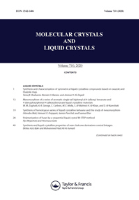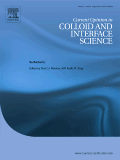
Soft Matter
Scope & Guideline
Exploring the Fluid Frontier of Science
Introduction
Aims and Scopes
- Polymer Science:
Research that delves into the synthesis, characterization, and properties of various polymers, including their mechanical behavior, phase transitions, and interactions with other materials. - Colloidal Systems:
Studies on the behavior and properties of colloidal suspensions, including their stability, dynamics, and interactions at interfaces. - Liquid Crystals:
Investigations into the properties and applications of liquid crystalline materials, with a focus on their phase behavior, ordering, and response to external fields. - Biological Soft Matter:
Research that explores the mechanics and dynamics of biological materials and systems, including cell behavior, tissue engineering, and biocompatible materials. - Nanomaterials and Nanocomposites:
Studies on the synthesis and properties of nanostructured materials and their incorporation into soft matter systems to enhance functionality and performance. - Active Matter:
Exploration of systems composed of self-propelling particles, including their collective behavior, phase transitions, and interactions with their environment.
Trending and Emerging
- Smart and Responsive Materials:
There is a growing interest in materials that can respond to external stimuli (e.g., temperature, pH, light) and exhibit tunable properties, with applications in soft robotics, sensors, and drug delivery. - Machine Learning and AI Applications:
The integration of machine learning techniques to predict material behaviors, optimize polymer designs, and analyze complex data sets is becoming increasingly prevalent in soft matter research. - Interfacial Science:
Research focusing on interfacial phenomena, including the properties and dynamics of interfaces in complex fluids, is trending due to its relevance in applications such as emulsions, foams, and coatings. - Biomimetic and Bioinspired Materials:
There is an emerging trend towards developing materials and systems inspired by biological structures and functions, particularly for applications in medicine and environmental sustainability. - Active Matter Systems:
The exploration of active matter, including self-propelling particles and their collective dynamics, is gaining traction, reflecting an interest in understanding nonequilibrium systems and their potential applications.
Declining or Waning
- Traditional Polymer Blends:
Research focused on conventional polymer blends is becoming less prevalent as more advanced materials and methodologies are explored, including stimuli-responsive and hybrid systems. - Basic Colloid Chemistry:
While foundational studies in colloid chemistry remain important, there is a noticeable decline in publications centered solely on basic colloidal interactions, as interest shifts towards complex systems and applications. - Static Characterization Techniques:
Techniques that are primarily static in nature are waning in popularity, with a growing emphasis on dynamic, time-resolved methods that capture the behavior of materials under various conditions. - Single Component Systems:
Research focusing on single-component systems is decreasing, as the trend moves towards investigating multi-component, hybrid systems that exhibit more complex behaviors.
Similar Journals

Liquid Crystals Today
Connecting Researchers to the Liquid Crystal CommunityLiquid Crystals Today, published by Taylor & Francis Ltd, is an essential platform for researchers and professionals focusing on the fascinating field of liquid crystals. With an ISSN of 1358-314X and an E-ISSN of 1464-5181, this journal covers significant advancements in areas such as Condensed Matter Physics, Inorganic Chemistry, and Materials Chemistry, reflected in its recent classification within the Q3 quartile across these categories. Established in 1991 and with a rich history of disseminating impactful research, the journal provides critical insights and discussions pertinent to the scientific community. Although it does not follow an open-access model, its rigorous peer-review process ensures high-quality publications that contribute to the body of knowledge in liquid crystals. Researchers looking to stay updated in this dynamic field will find Liquid Crystals Today an invaluable resource.

MOLECULAR CRYSTALS AND LIQUID CRYSTALS
Decoding the Dynamics of Molecular OrganizationMOLECULAR CRYSTALS AND LIQUID CRYSTALS is a distinguished journal published by Taylor & Francis Ltd, dedicated to the comprehensive examination of the structural and physical properties of molecular crystals and liquid crystals, with applications spanning fields such as chemistry, materials science, and condensed matter physics. Established in 1972, this journal has carved out a niche in the academic landscape despite facing recent challenges, as reflected in its current quartile rankings of Q4 across multiple categories in 2023. The journal not only serves as a platform for groundbreaking research but also invites contributions that further explore the intricate relationships between molecular organization and material properties, thereby advancing our understanding of these fascinating substances. With a commitment to fostering scientific dialogue, MOLECULAR CRYSTALS AND LIQUID CRYSTALS aims to reach a broad audience of researchers, professionals, and students, providing insights that are pivotal in driving innovation in materials research.

Soft Robotics
Exploring the Intersection of Nature and Technology in Robotics.Soft Robotics, published by MARY ANN LIEBERT, INC, stands as a leading journal dedicated to advancing the field of soft robotics, which merges insights from artificial intelligence, biophysics, and control systems engineering to innovate in areas such as bio-inspired design, human-robot interaction, and flexible robotics. With a distinguished Q1 ranking in multiple categories, including Artificial Intelligence, Biophysics, and Control and Systems Engineering, this journal places itself at the cutting edge of interdisciplinary research, boasting impressive Scopus rankings that reflect its rigorous scholarship and influential contributions to the scientific community. Although it is not an open access journal, it provides valuable insights and findings for researchers, professionals, and students eager to explore the transformative potential of soft robotics in practical applications. The journal has published continuously since its inception in 2014, and will continue to converge between theory and application through 2024, emphasizing its commitment to expanding the frontiers of knowledge in this dynamic field. For those engaged in the exploration of robotics technologies shaped by soft materials and adaptive mechanisms, Soft Robotics is an essential resource that fuels innovation and discovery.

GIANT
Connecting Scholars to Transformative Ideas in Chemistry.GIANT is a pioneering open-access journal published by Elsevier that has rapidly established itself as a cornerstone in the fields of Chemistry, Materials Chemistry, Polymers and Plastics, and Surfaces, Coatings and Films. Since its inception in 2020, GIANT has been committed to disseminating cutting-edge research and facilitating scholarly communication in these dynamic areas. With a remarkable Q1 ranking across multiple categories, the journal reflects an impressive impact factor within the academic community, evidenced by its standing in the top 82nd percentile in several Scopus classifications. Based in the Netherlands at Radarweg 29, Amsterdam, GIANT embraces a global audience through its open-access model, ensuring that groundbreaking discoveries are accessible to researchers, professionals, and students alike. Fostering innovation, the journal strives to shape the future of materials science and chemistry, making significant contributions in an era characterized by rapid scientific advancement.

Colloids and Interfaces
Advancing the Frontiers of Colloid ScienceColloids and Interfaces is a cutting-edge open access journal published by MDPI based in Switzerland, focusing on innovative research in the fields of colloid and surface chemistry. Established in 2017, this journal has quickly become a significant platform for sharing critical insights and advancements within the discipline, maintaining a commendable impact factor that reflects its scholarly importance. With a Q2 ranking in miscellaneous chemistry and a Q3 rank in colloid and surface chemistry, it stands as a vital resource for researchers and professionals dedicated to the study of colloidal phenomena. The journal's open access policy, initiated in 2018, ensures that findings are readily available to a global audience, fostering collaboration and innovation. As it continues to converge research until 2024, Colloids and Interfaces is positioned to further enhance the burgeoning field of colloidal science.

Advances in Physics-X
Driving the Dialogue in Physics and AstronomyAdvances in Physics-X is a premier open-access journal published by Taylor & Francis Ltd, dedicated to advancing the frontiers of knowledge in the field of Physics and Astronomy. Since its inception in 2016, the journal has established itself as a vital platform for researchers and professionals, showcasing innovative research and cutting-edge theories that influence a broad array of sub-disciplines within physics. With an impressive impact factor and ranked in the 94th percentile among its peers, it resides in the Q1 category for Physics and Astronomy (miscellaneous), indicating its significant contributions to the academic community. Located in the United Kingdom, the journal encourages open access to foster wider dissemination and visibility of scholarly works, aligning with contemporary academic trends that prioritize global knowledge sharing. The ongoing commitment to publishing high-quality research ensures that Advances in Physics-X remains an essential resource for students, industry experts, and academics alike, helping to shape the future of physics research through collaboration and innovation.

CURRENT OPINION IN COLLOID & INTERFACE SCIENCE
Bridging Theory and Application in Colloid ResearchCURRENT OPINION IN COLLOID & INTERFACE SCIENCE, published by Elsevier Science London, serves as a premier platform for researchers and professionals in the field of colloid, interface science, and related disciplines. With an impressive Q1 ranking in multiple categories including Colloid and Surface Chemistry, Physical and Theoretical Chemistry, Polymers and Plastics, as well as Surfaces and Interfaces, this journal showcases cutting-edge developments and expert opinions that drive innovation in these areas. As a leader in its field, it maintains robust academic standards, reflected in its high percentile rankings across various Scopus categories, such as 3rd in Surfaces and Interfaces and 10th in Physical and Theoretical Chemistry. While the journal is not Open Access, it provides valuable insights to a wide audience, making it an essential resource for advancing knowledge and fostering collaborations among researchers, academics, and industry professionals alike. With a continual publication timeline extending from 1996 to 2024, it captures the evolving landscape of colloid and interface science, ensuring that readers are equipped with the latest findings and perspectives.

ADVANCED MATERIALS
Shaping Tomorrow's Technologies through Advanced MaterialsAdvanced Materials, published by Wiley-VCH Verlag GmbH, is a premier academic journal that serves as a crucial platform for cutting-edge research in the field of materials science and engineering. With an impressive impact factor and ranking among the top tiers in various categories, including Materials Science, Mechanical Engineering, and Nanoscience, this journal is recognized for its high-quality contributions and relevance to contemporary research challenges. Spanning from 1989 to 2024, Advanced Materials not only features groundbreaking studies but also provides insights into innovative applications and advancements in material design and engineering. Researchers, professionals, and students alike will benefit from the rigorous peer-review process and diverse range of topics covered, making it an indispensable resource for those aiming to stay at the forefront of materials science innovation.

SOFT MATERIALS
Exploring the Frontiers of Soft Material InnovationSOFT MATERIALS is a premier journal specializing in the dynamic and interdisciplinary fields of chemistry, condensed matter physics, and materials science. Published by Taylor & Francis Inc., the journal serves as a vital platform for researchers and professionals to disseminate their cutting-edge findings related to soft materials, which are pivotal to advancements in various applications such as nanotechnology, biotechnology, and polymers. With an ISSN of 1539-445X and an E-ISSN of 1539-4468, this journal has successfully built a reputation within the academic community since its inception in 2004. As of 2023, SOFT MATERIALS is ranked within the Q3 category in Chemistry (miscellaneous), Condensed Matter Physics, and Materials Science (miscellaneous), reflecting its growing influence as a respected source of scientific knowledge. Although it does not currently operate under an open access model, its substantial impact factor and Scopus rankings, which place it in the 39th to 45th percentile across pertinent categories, highlight its quality and significance in fostering research collaboration and discourse among scholars and practitioners worldwide. The journal's objectives include enhancing the understanding of the physical, chemical, and material properties of soft materials, making it an essential resource for students, researchers, and professionals passionate about materials innovation and development.

Liquid Crystals Reviews
Advancing Knowledge in Liquid Crystal TechnologyLiquid Crystals Reviews, published by Taylor & Francis Ltd, is an esteemed journal dedicated to the nuanced field of liquid crystal technology and its applications. With an ISSN of 2168-0396 and an E-ISSN of 2168-0418, this journal has established itself as a vital resource for researchers, professionals, and students alike, providing a platform for rigorous peer-reviewed articles and innovative research findings. Impressively, it holds a Q1 ranking in Chemistry, Condensed Matter Physics, and Materials Science as of 2023, underscoring its significance in these disciplines. The journal spans a convergence period from 2013 to 2024, inviting high-quality contributions that lead to foundational advancements in understanding the properties and uses of liquid crystals. While the journal is not open access, its impact on the scientific community is profound, serving as a cornerstone for knowledge dissemination and advancement in liquid crystal research. Located in the United States with its publishing office in England, Liquid Crystals Reviews operates at the crossroads of innovation and academic excellence.